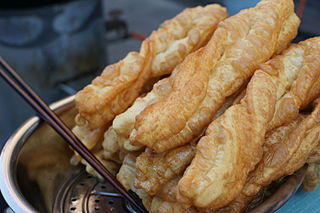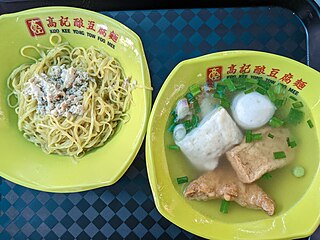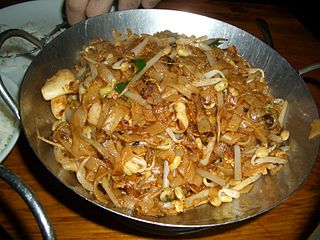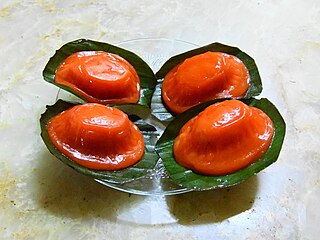
A mochi is a Japanese rice cake made of mochigome (もち米),a short-grain japonica glutinous rice,and sometimes other ingredients such as water,sugar,and cornstarch. The steamed rice is pounded into paste and molded into the desired shape. In Japan,it is traditionally made in a ceremony called mochitsuki. While eaten year-round,mochi is a traditional food for the Japanese New Year,and is commonly sold and eaten during that time.

Malaysian cuisine consists of cooking traditions and practices found in Malaysia,and reflects the multi-ethnic makeup of its population. The vast majority of Malaysia's population can roughly be divided among three major ethnic groups:Malays,Chinese and Indians. The remainder consists of the indigenous peoples of Sabah and Sarawak in East Malaysia,the Orang Asli of Peninsular Malaysia,the Peranakan and Eurasian creole communities,as well as a significant number of foreign workers and expatriates.

Youtiao,known in Southern China as yu char kway,is a long golden-brown deep-fried strip of wheat flour dough of Chinese origin and also popular in other East and Southeast Asian cuisines.

Kuih are bite-sized snack or dessert foods commonly found in Southeast Asia and China. It is a fairly broad term which may include items that would be called cakes,cookies,dumplings,pudding,biscuits,or pastries in English and are usually made from rice or glutinous rice. In China,where the term originates from,kueh or koé (粿) in the Min Nan languages refers to snacks which are typically made from rice but can occasionally be made from other grains such as wheat. The term kuih is widely used in Malaysia,Brunei,and Singapore,kueh is used in Singapore and Indonesia,kue is used in Indonesia only,all three refer to sweet or savoury desserts.

Yong tau foo is a Hakka Chinese dish consisting primarily of tofu filled with ground meat mixture or fish paste. Variations on this dish feature —instead of tofu —vegetables and mushrooms stuffed with ground meat or fish paste. Yong tau foo is eaten in numerous ways,either dry with a sauce or served as a soup dish.

Grass jelly,also known as leaf jelly or herb jelly,is a jelly-like dessert originating in China. It is commonly consumed in East Asia and Southeast Asia. It is created by using Chinese mesona and has a mild,slightly bitter taste. Grass jelly was invented by the Hakka people who historically used the food to alleviate heat stroke after long days working in the field. The dish was introduced to Southeast Asia by the Chinese diaspora. It is served chilled,with other toppings,such as fruit,or in bubble tea or other drinks. Outside Asia,it is sold in Asian supermarkets.

Malaysian Chinese cuisine is derived from the culinary traditions of Chinese Malaysian immigrants and their descendants,who have adapted or modified their culinary traditions under the influence of Malaysian culture as well as immigration patterns of Chinese to Malaysia. Malaysian Chinese cuisine is predominantly based on an eclectic repertoire of dishes with roots from Fujian,Cantonese,Hakka and Teochew cuisines.

Banmian or pan mee is a popular Chinese noodle dish,consisting of handmade noodles served in soup. Other types of handmade noodles include youmian,or mee hoon kueh.

Penang cuisine is the cuisine of the multicultural society of Penang,Malaysia. Most of these cuisine are sold at road-side stalls,known as "hawker food" and colloquially as "muckan carts". Local Penangites typically find these hawker fares cheaper and easier to eat out at due to the ubiquitousness of the hawker stalls and that they are open for much of the day and night. Penang island. On February 22,2013,Penang was ranked by CNN Travel as one of the top ten street food cities in Asia. Penang has also been voted by Lonely Planet as the top culinary destination in 2014.

Ipoh has a significant food scene with many hawker centres and restaurants. It has dishes derived from Malay,Chinese and Indian cuisine. In recent years,Ipoh has seen an increase in international restaurants,bars and gastropubs which have become popular with locals and tourists.

Tangyuan are a traditional Chinese dessert made of glutinous rice shaped into balls that are served in a hot broth or syrup. They come in varying sizes,anything between a marble to a ping-pong ball,and are sometimes stuffed with filling. Tangyuan are traditionally eaten during the Lantern Festival,but because the name is a homophone for reunion and symbolizes togetherness and completeness,this dish is also served at weddings,family reunions,Chinese New Year,and the Dōngzhìfestival.

Qīngtuán,also written as Tsingtuan,is a green-colored dumpling originating from Jiangnan and common throughout China. It is made of glutinous rice mixed with Chinese mugwort or barley grass. It is usually filled with sweet red or black bean paste. The exact technique for making qingtuan is quite complicated and the grass involved is only edible in the early spring,so it is typically only available around the time of the Qingming Festival (April 4 or 5),with which the rice cake has become associated. Nowadays,qingtuan sold in most convenience stores in China are made of glutinous rice mixed with matcha. Modern versions use a wider variety of fillings,such as rousong or salted egg yolk.

Ang ku kueh,also known as red tortoise cake,is a small round or oval-shaped Chinese sweet dumpling with soft,sticky glutinous rice flour skin wrapped around a sweet central filling. It is molded to resemble a tortoise shell and is presented resting on a square piece of banana leaf. As suggested by its name,red tortoise cakes are traditionally red in color and has a sticky,chewy texture when eaten. Red tortoise cakes are shaped like tortoise shells because the Chinese traditionally believed that eating tortoises would bring longevity,good fortune and prosperity. Considered to be auspicious items,these sweet pastries are especially prepared during important festivals such as Chinese New Year as offerings to the Chinese deities.

Apam balik also known as martabak manis,terang bulan,peanut pancake or mànjiānguǒ,is a sweet dessert originating in Fujian cuisine which now consists of many varieties at specialist roadside stalls or restaurants throughout Brunei,Indonesia,Malaysia and Singapore. It can also be found in Hong Kong as,Taiwan as,Southern Thailand as Khanom Thang Taek (ขนมถังแตก) and in the Sulu Archipelago,Philippines as Tarambulan.

Hao kuih is a special snack originating in Shantou,Guangdong Province,China. It is known for its shape and flavor. First appearing in Chaoyang District in Shantou,Hao kuih is generally not well known beyond the Chaoshan community.
















